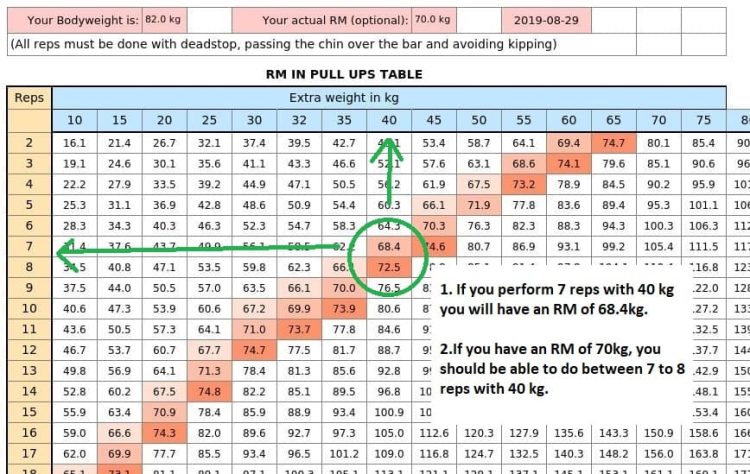Pull-ups, and their close relative chin-ups, are great for building a bigger back and stronger arms. But, after a few months of training, many people can crank out 10, 15, or even 20 reps.
While you could just keep on doing more and more reps, you’ll probably get better results if you add weight to make them more challenging. That’s especially true if you want to increase muscle mass or get stronger.
But how much extra weight should you use?
Use our weighted pull-up calculator to estimate your pull-up one rep max and see how many reps you should be able to do with a given weight.
The Pull Up Calculator
Unit weight type:
Option 1: Specific result
Calculator Mode :
Your bodyweight :
Input your RM :
Added weight :
Number of Repetitions :
What Is the One Rep Max Weighted Pull-Up Calculator?
Your one-repetition maximum, or one rep max (1RM for short), is the amount of weight you can lift once, but not twice. It’s basically a measure of your strength. You can test for your 1RM by lifting progressively heavier weights until you hit failure, but this can be very tiring and stressful.
However, instead of testing your one rep max, you can use a calculator to estimate how much weight you can lift for a single repetition.
Level Up Your Fitness: Join our 💪 strong community in Fitness Volt Newsletter. Get daily inspiration, expert-backed workouts, nutrition tips, the latest in strength sports, and the support you need to reach your goals. Subscribe for free!
This is invariably safer and more convenient. Just pick a weight, do as many reps as possible, and then enter your results into the data fields – simple!
In return, you’ll discover your estimated 1RM and also find out how many reps you should be able to do with a given weight.
All this information can be helpful when designing a new workout. For example, you might want to do sets of five reps with 85% of your 1RM or need to know what weight you should use for sets of ten reps.
Using our one rep max weighted pull-up calculator will take a lot of the guesswork out of setting up your next training cycle.
How to Use the One Rep Max Weighted Pull-Up Calculator
Our one-rep max weighted pull-up calculator is straightforward to use. Just follow these steps:
Option 1: Compute Specific Result
1- Calculator Mode: Reps to RM
- Select your units – kilograms or pounds.
- Enter your body weight.
- Input the amount of additional weight used.
- Input the number of reps you performed.
- Read off your estimated weighted pull-up 1RM.
2- Calculator Mode: RM to Reps for Specific Weight
- Select your units – kilograms or pounds.
- Enter your body weight.
- Enter your one rep max.
- Enter the amount of weight you want to use.
- Read off the number of pull-ups you should be able to do with your chosen weight.
3- Calculator Mode: RM to Weight for Specific Reps
- Select your units – kilograms or pounds.
- Enter your body weight.
- Enter the one rep max.
- Enter the number of pull-ups you want to be able to do.
- Read off the weight you should be able to use for the specified number of reps.
Option 2: Calculate the Table
This option produces a table of your 1RM and various percentages and rep maxes based on that result. Print it out and carry it with you so you can quickly determine how much weight to use or how many reps you should do during your workouts.
- Select your units – kilograms or pounds
- Enter your bodyweight
- Enter your 1RM for the weighted pull-up
- View the table (see example below).

How to Improve Your Weighted Pull-Up Score
If you care about your weighted pull-up one rep max, you probably want to improve it. Here are the training methods and strategies you need to use to achieve new weighted pull-up 1RM.
1. Grease the groove
Getting good at pull-ups requires practice. After all, pull-ups are not just a way to test and develop strength; they’re also a skill. The better your technique, the more efficient you’ll be, and the more weight you’ll be able to lift.
One of the best ways to become a pull-up master is a technique called grease the groove. With this method, you do lots of easy sets spread throughout your day, none of which take you anywhere near failure. This is arguably one of the best ways to get better at an exercise without impacting the rest of your workouts.
Improving your general pull-up performance will have a knock-on effect on your ability to do weighted pull-ups. Simple do anywhere from 5-10 easy sets of weighted pull-ups per day.
2. Lose weight
Losing fat will probably improve your weighted pull-up performance. After all, fat is stored energy and essentially dead weight during the pull-up movement.
Losing weight usually involves eating a little less and exercising a little more to create a calorie deficit. Faced with this energy shortfall, your body will have no choice but to burn fat for fuel, and you’ll gradually lose weight.
Losing weight slowly and gradually is almost always best because a) you won’t lose much muscle, b) you’ll still have plenty of energy for training, and c) you won’t have to suffer extreme hunger.

3. Focus on low reps and long rests
When it comes to getting better at weighted pull-ups, you need to make every rep you perform as good as possible. Scrappy reps or trying to do reps when you are tired will not enhance your long-term performance or build strength.
So, keep your reps relatively low, stopping a few short of failure, and take long rests between sets to ensure that you are fully recovered. 3-5 minutes between sets is a good place to start, but feel free to rest longer if you wish.
Level Up Your Fitness: Join our 💪 strong community in Fitness Volt Newsletter. Get daily inspiration, expert-backed workouts, nutrition tips, the latest in strength sports, and the support you need to reach your goals. Subscribe for free!
4. Do over-weighted negatives
You are stronger eccentrically than you are concentrically. That means you can lower more weight than you can lift.
Overloading the eccentric phase of your pull-up will increase your concentric strength and provides a good way to expose your muscles to more weight than you can usually handle. This is called negative training.
To do this, load up your dipping belt or weight vest with your weighted pull-up 1RM or even a little more.
Next, use your legs to climb up into the starting position of the pull-up and then lower yourself down slowly. Climb back up and repeat until you can no longer control your descent.
Use this strategy to increase your strength, but beware – eccentric training can cause severe post-workout muscle soreness.
5. Don’t neglect rest, recovery, and food
Training with heavy weights to build strength and muscle mass takes a lot out of your body. Therefore, you need to make sure your diet and lifestyle put back in what your workouts take out.
Make sure you:
- Get 7-9 hours of sleep per night – weekends as well as weekends.
- Eat healthy, nutritious foods.
- Consume around one gram of protein per pound of body weight.
- Avoid too much junk food, refined sugar, soda, processed food, etc.
- Create a slight calorie surplus to fuel your workouts, recovery, and muscle growth.
- Go easy on the alcohol.
- Have 1-2 days off from training per week.
6. Be patient and consistent
Unless you are a beginner, increases in strength and muscle mass tend to accumulate slowly. It takes months if not years of consistent training to build big, powerful muscles. So, you need to be patient and knuckle down for the long haul.
And remember, the more workouts you miss, the slower your progress will be. Consistency and persistence is critical for your strength and muscle-building progress.
FAQ
1. How often should I retest my weighted triceps dip one rep max?
One of the best things about our weighted pull-up 1RM calculator is that you can retest your pull-up max whenever you want. Just input your current bodyweight weight, added weight, and the number of reps completed to determine your current 1RM.
In contrast, “real” repetition maximum testing is so strenuous that you should only do it once every couple of months, and beginners should probably avoid it altogether.
2. How many reps should I do to estimate my weighted pull-up 1RM?
All one-rep max calculators use equations to estimate your 1RM. While most allow you to input ten or more reps, you’ll get the most accurate results if you stick to the 3-5 rep range. The lower your rep count, the more precise your one rep max result will be.
3. What is the best way to add weight to pull-ups?
There are a few different ways you can add weight to your pull-ups. The best options are:
- Dipping belts – despite the name, dipping belts can be used for pull-ups and chin-ups. They have wide backs and are fitted with cords or chains so you can suspend dumbbells or weight plates from your hips. They’re comfortable and easy to adjust.
- Weighted vest – weighted vests are comfortable and widely available. You can also wear one for many other exercises, including pull-ups, push-ups, and cardio. On the downside, they can be expensive and are often fiddly to adjust.
- Backpack – if you’ve got a backpack, you can fill it with weights or books and wear it for pull-ups. While this is a convenient and cost-effective option, it may not be the most comfortable, as all the weight will be on your back, and may pull you off balance during pull-ups.
- Yoga strap – you can put a yoga strap around your hips and hang weights from it for pull-ups. However, there is no padding, so heavy weights will be uncomfortable. But, on the plus side, this is a very cheap option, and yoga straps are light and portable.
Finally, you can just clamp and hold a dumbbell between your knees or crossed ankles. Unfortunately, this is not comfortable or practical with anything other than very light weights.
4. Does this calculator work for pull-ups and chin-ups
Pull-ups are performed with an overhand or pronated grip, while chin-ups are done with an underhand or supinated grip. Despite these differences, pull-ups and chin-ups are pretty interchangeable, and both work the same muscles.
Because the exercises are so similar, you can use this calculator for weighted pull-ups and chin-ups. However, most people are stronger at chin-ups than pull-ups, so make sure you establish a 1RM for both exercises.
5. Are weighted pull-ups and chin-ups good for building muscle?
Adding weight to pull-ups and chin-ups is an excellent way to overload the muscles used in these two exercises. Both movements work your latissimus dorsi and biceps. As such, you can definitely use pull-ups and chin-ups to build muscle, provided you take your sets to within a couple of reps of failure.
Chin-ups are especially useful for building bigger biceps, as they closely replicate the demands of barbell curls. Your forearms will also get a valuable workout, and your grip should become stronger.
6. Are weighted pull-ups safe?
Weighted pull-ups are generally safe for most exercisers, but the proviso is that you do them with good technique. That means:
- Not swinging or jerking yourself up.
- Keeping your shoulders down and back throughout.
- Not relaxing between reps or hyperextending your elbows.
- Keeping your core tight.
- Not arching your neck backward.
- Lowering yourself smoothly and under control and not just dropping down.
7. What is a good weighted pull-up score?
Considering that many exercisers cannot do even one bodyweight pull-up, any weighted pull-up is a pretty good achievement. That said, there are some very strong people around who can do weighted pull-ups with an additional 50-100% of the body weight!
There are recognized strength standards for most exercises, and that includes weighted pull-ups. See how your weighted pull-up 1RM measures up here.
8. Why do I need to know my weighted muscle-up 1RM?
There are a couple of situations where knowing your weighted pull-up one rep max may be helpful:
- Program planning – many workouts involve training with a specific percentage of your 1RM, e.g., 75%. While you could estimate this weight, your workout will be more effective if you have a more accurate idea of your 1RM.
- Tracking your progress – it’s not always easy to tell if you are getting stronger. Testing and then retesting your pull-up 1RM every few weeks will reveal if your strength is increasing or if your program is less effective than you hoped it would be.
- Just for fun – why not challenge your training buddies to an informal weighted pull-up competition? Use our calculator to compare results without doing a real one-rep test.
Related Calculators:
Wrapping Up
Take the guesswork out of programming weighted pull-ups with our accurate and easy-to-use one-rep max calculator.
Knowing your weighted pull-up 1RM can be helpful when planning your workout cycles or measuring your strength training progress. Unlike a “real” 1RM test, using our weighted pull-up calculator is easy and safe, and you can retest your one rep max whenever you want.
You can also use this one-rep max weighted pull-up calculator to estimate how many reps you should be able to do with a specific weight. This is very useful when deciding what loads to use in your workouts.








